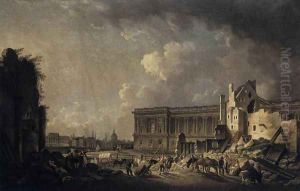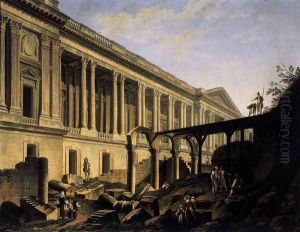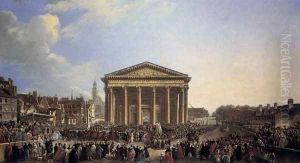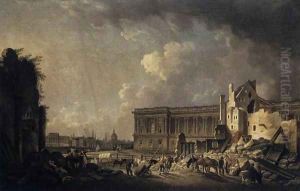Pierre-Antoine de Machy Paintings
Pierre-Antoine Demachy, often known as Antoine or Pierre-Antoine de Machy, was a French artist recognized for his architectural paintings, particularly his detailed depictions of ruins and urban scenes in the 18th century. Born on September 17, 1723, in Paris, France, Demachy was a product of the Rococo period but his work also intersected with the emerging Neoclassical style, reflecting a fascination with the past and a meticulous attention to architectural accuracy.
Demachy studied under the French painters Jean II Restout and Francesco Casanova, which helped him develop his skills in perspective and the rendering of architectural elements. He was accepted into the Académie Royale de Peinture et de Sculpture in 1755 as a painter of 'fêtes galantes' (elegant outdoor entertainments), but his interest soon shifted towards the depiction of ruins, which became his primary subject matter.
His works often depict dilapidated buildings and structures, imbued with a sense of nostalgia and the passage of time. Such images resonated with the Enlightenment-era sentiments of his contemporaries, who were fascinated by the ruins of classical antiquity. Demachy’s paintings were more than just straightforward representations; they often included figures and activities that gave life to the scenes and conveyed moral and philosophical messages.
Demachy's popularity grew, and he received commissions from various patrons, including the French government. His paintings were exhibited at the Paris Salon, the official art exhibition of the Académie des Beaux-Arts in Paris, where they were met with acclaim. Besides his paintings, Demachy was also known for his stage designs, which he created for various Parisian theaters, including the Opéra. These works further demonstrated his skill in creating convincing architectural spaces.
The French Revolution brought significant changes to the art world, and like many of his contemporaries, Demachy's later life was marked by financial difficulties and changes in artistic tastes. Nevertheless, he continued to work until his death in Paris on October 14, 1807. Today, Demachy's works can be found in museums and collections around the world, serving as valuable documents of 18th-century urban landscapes and as examples of the period’s artistic preoccupations with the aesthetics of decay, history, and the passage of time.



